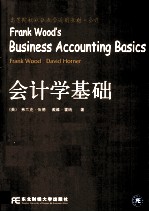
- 作 者:(英)伍德,(英)霍纳著
- 出 版 社:沈阳:东北财经大学出版社
- 出版年份:2011
- ISBN:9787565403002
- 标注页数:305 页
- PDF页数:319 页
请阅读订购服务说明与试读!
订购服务说明
1、本站所有的书默认都是PDF格式,该格式图书只能阅读和打印,不能再次编辑。
2、除分上下册或者多册的情况下,一般PDF页数一定要大于标注页数才建议下单购买。【本资源319 ≥305页】
图书下载及付费说明
1、所有的电子图书为PDF格式,支持电脑、手机、平板等各类电子设备阅读;可以任意拷贝文件到不同的阅读设备里进行阅读。
2、电子图书在提交订单后一般半小时内处理完成,最晚48小时内处理完成。(非工作日购买会延迟)
3、所有的电子图书都是原书直接扫描方式制作而成。
CHAPTER 1 Introduction 1
Learning objectives 1
Introduction 1
Sectors in the economy 1
Types of business organisation 2
Business objectives 3
Fundamentals of financial accounting 3
The accounting equation 4
International standards 5
Terminology 5
Summary 5
CHAPTER review 6
Key terms 6
Review questions 6
CHAPTER 2 Double-entry bookkeeping 9
Learning objectives 9
Introduction 9
What does the account show? 9
Rules for double-entry transactions 10
Further information for double-entry bookkeeping 12
Accounting for inventory 12
What do we mean by inventory? 13
Double-entry transactions for inventory 13
Returns of inventory 15
Drawings 17
Income and expenses 17
How many different expense accounts should be opened? 18
Balancing accounts 19
CHAPTER review 21
Handy hints 22
Key terms 22
Review questions 23
CHAPTER 3 Financial statements 28
Learning objectives 28
Introduction 28
Trial balance 29
Statement of comprehensive income 30
Statement of financial position 35
Further adjustments to the statement of comprehensive income 38
CHAPTER review 40
Relevant accounting standards 40
Handy hints 41
Key terms 41
Review questions 42
CHAPTER 4 Day books and ledgers 52
Learning objectives 52
Introduction 52
Ledgers 52
Day books 53
Cash books 53
Cash and trade discounts 55
Three-column cash books 56
Petty cash book 57
Sales day book 59
Purchases day book 60
Returns day books 62
The journal 63
The use of folio columns 65
CHAPTER review 65
Handy hints 66
Key terms 66
Review questions 67
CHAPTER5 Value added tax 76
Learning objectives 76
Introduction 76
The administration of VAT 76
VAT and double-entry bookkeeping 77
Other items in the VAT account 81
VAT and discounts 82
CHAPTER review 83
Handy hints 83
Key terms 84
Review questions 84
CHAPTER 6 Capital and revenue expenditure 88
Learning objectives 88
Introduction 88
Classifying capital and revenue expenditure 88
Joint expenditure 90
Capital and revenue receipts 90
Areas of debate 90
Incorrect classification of expenditure 92
CHAPTER review 92
Relevant accounting standards 92
Handy hints 92
Key terms 93
Review questions 93
CHAPTER 7 Accounting concepts and standards 98
Learning objectives 98
Introduction 98
Financial statements-the underlying principles 98
Accounting concepts 100
Introduction to accounting standards 101
CHAPTER review 103
Handy hints 104
Key terms 104
Review questions 104
CHAPTER 8 Adjustments to the financial statements 107
Learning objectives 107
Introduction 107
Accruals 107
Prepayments 109
Revenue 109
Accruals and prepayments and the statement of financial position 110
Dealing with trial balances when outstanding balances exist 111
Dealing with balances from more than one year 112
Links with other topics 114
CHAPTER review 114
Handy hints 114
Key terms 114
Review questions 115
CHAPTER 9 Bad debts and provision for doubtful debts 123
Learning objectives 123
Introduction 123
Accounting for bad debts 123
How can a business minimise the risk of bad debts? 125
Provision for doubtful debts 125
Calculating the size of the provision for doubtful debts 126
Accounting entries for the provision for doubtful debts 126
Provision for doubtful debts and the statement of financial position 128
Bad debts recovered 128
Provision for discounts on debtors 129
CHAPTER review 130
Handy hints 130
Key terms 130
Review questions 131
CHAPTER 10 Depreciation of non-current assets 135
Learning objectives 135
Introduction 135
Why do assets lose value? 135
Do all assets lose value? 136
Methods of depreciation 137
Straight line method 137
Reducing balance method 137
Depreciation and the statement of financial position 138
A comparison of the two methods 139
Changing methods of depreciation 139
Mid-year purchases and sales 140
Depreciation and double-entry bookkeeping 141
Asset disposal 142
Depreciation of intangible assets 145
CHAPTER review 145
Relevant accounting standards 146
Handy hints 146
Key terms 146
Review questions 146
CHAPTER 11 Errors and suspense accounts 151
Learning objectives 151
Introduction 151
Errors that don’t affect the trial balance agreement 151
Correction of the errors 152
Errors that do affect the trial balance agreement 156
Errors and profits 158
CHAPTER review 159
Handy hints 160
Key terms 160
Review questions 160
CHAPTER 12 Control accounts 165
Learning objectives 165
Introduction 165
Information used in the control accounts 165
Memorandum accounts 166
Layout of control accounts 167
Other items found in control accounts 169
Use of control accounts 170
CHAPTER review 174
Handy hints 174
Key terms 174
Review questions 174
CHAPTER 13 Bank reconciliation statements 179
Learning objectives 179
Introduction 179
Procedure for bank reconciliation 180
Identifying items not appearing both in the cash book and on the bank statement 181
Bringing the cash book up to date 182
Updated cash book 183
Producing the bank reconciliation statement 184
Further information concerning construction of bank reconciliation statements 185
CHAPTER review 186
Handy hints 186
Key terms 186
Review questions 187
CHAPTER 14 Manufacturing accounts 192
Learning objectives 192
Introduction 192
How costs are classified 192
Prime cost 193
Indirect manufacturing costs 195
After the manufacturing account is completed 197
Factory profit 197
Provision for unrealised profit on unsold inventory 198
CHAPTER review 200
Handy hints 200
Key terms 200
Review questions 201
CHAPTER 15 Limited companies 210
Learning objectives 210
Introduction 210
Types of limited company 210
Differences between public and private limited companies 211
Shares and shareholders 212
Debentures 214
Financial statements of limited companies 214
Reserves 218
CHAPTER review 223
Relevant accounting standards 223
Handy hints 224
Key terms 224
Review questions 225
Appendix 1 Answers to review questions 233
Appendix 2 Glossary 298
